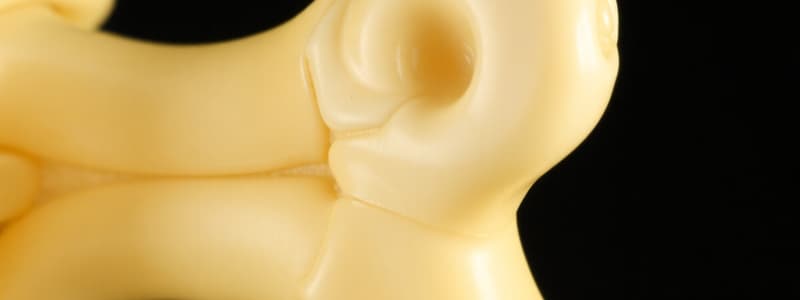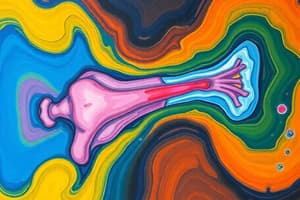Podcast
Questions and Answers
What happens to the chondrocytes in the early stages of endochondral ossification?
What happens to the chondrocytes in the early stages of endochondral ossification?
- They transform directly into osteoblasts.
- They multiply and increase the cartilage size.
- They die and create cavities in the cartilage. (correct)
- They migrate to the perichondrium.
What role do blood vessels play in the process of endochondral ossification?
What role do blood vessels play in the process of endochondral ossification?
- They facilitate the conversion of perichondrium cells to osteoblasts. (correct)
- They carry minerals needed for cartilage to remain intact.
- They only penetrate the cartilage in the later stages.
- They nourish the cartilage without contributing to ossification.
During the remodeling phase of endochondral ossification, what is primarily formed?
During the remodeling phase of endochondral ossification, what is primarily formed?
- Hyaline cartilage surrounding the bone.
- A medullary cavity within the shaft. (correct)
- Fibrous tissue in the perichondrium.
- Compact bone in the epiphyses.
What ultimately fills the epiphyses during endochondral ossification?
What ultimately fills the epiphyses during endochondral ossification?
Which statement best describes the initial structure of bones formed by endochondral ossification?
Which statement best describes the initial structure of bones formed by endochondral ossification?
What is the role of chondrocytes in the epiphyseal plate during postnatal bone growth?
What is the role of chondrocytes in the epiphyseal plate during postnatal bone growth?
Which process occurs when chondrocytes in the primary ossification site stop secreting collagen?
Which process occurs when chondrocytes in the primary ossification site stop secreting collagen?
What happens to cartilage after it undergoes the process of ossification?
What happens to cartilage after it undergoes the process of ossification?
How do osteoblasts contribute to lateral bone growth?
How do osteoblasts contribute to lateral bone growth?
Which of the following accurately describes the state of most bones at birth?
Which of the following accurately describes the state of most bones at birth?
What is the role of osteoprogenitor cells in bone formation?
What is the role of osteoprogenitor cells in bone formation?
What happens to mature chondrocytes during the bone formation process?
What happens to mature chondrocytes during the bone formation process?
How do new osteons form during the appositional growth of bone?
How do new osteons form during the appositional growth of bone?
What is required for the enlargement of the medullary cavity during appositional growth?
What is required for the enlargement of the medullary cavity during appositional growth?
What triggers the closure of growth plates at puberty?
What triggers the closure of growth plates at puberty?
How is bone remodeling maintained throughout life?
How is bone remodeling maintained throughout life?
What is the significance of osteoblasts and osteoclasts in bone growth?
What is the significance of osteoblasts and osteoclasts in bone growth?
Which of the following best describes the action of osteoblasts during periosteum activity?
Which of the following best describes the action of osteoblasts during periosteum activity?
What keeps bone thickness and shape properly maintained during life?
What keeps bone thickness and shape properly maintained during life?
Flashcards are hidden until you start studying
Study Notes
Endochondral Ossification
- Most bones develop through endochondral ossification, replacing hyaline cartilage with bone.
- Hyaline cartilage model, perichondrium, and osteoblasts are key components.
Steps of Endochondral Ossification
- Step 1: Cartilage enlarges, chondrocytes in the center die and disintegrate leaving cavities.
- Step 2: Blood vessels grow around the cartilage, perichondrium cells become osteoblasts, forming a bone collar.
- Step 3: Blood vessels penetrate the cartilage, osteoblasts produce spongy bone at the primary ossification center.
- Step 4: Remodeling creates a marrow cavity, bone thickens and lengthens. Osteoclasts break down trabeculae, osteoblasts continue adding bone.
- Step 5: Capillaries and osteoblasts migrate into epiphyses, creating secondary ossification centers.
- Step 6: Epiphyses fill with spongy bone, articular cartilage remains exposed to the joint cavity. An epiphyseal cartilage separates the epiphysis from diaphysis.
Postnatal Growth of Bones
- Growth in length occurs through chondrocyte division and growth in the epiphyseal plate.
- Osteoblasts replace cartilage with bone, leading to bone growth.
- Bone growth is under hormonal control, complete after puberty.
- Lateral growth is achieved by osteoblasts in the periosteum laying down new bone and osteoclasts in the medullary cavity breaking down old bone.
Bone Development from Hyaline Cartilage
- Calcification of the matrix occurs.
- Chondrocytes die, leaving cavities.
- Osteoid tissue (osteoblasts and clasts) replaces cartilage.
Formation of New Osteons and Central Canals
- Ridges in the periosteum create a groove for a blood vessel.
- Ridges fuse, forming an endosteum-lined tunnel.
- Osteoblasts in the endosteum build new concentric lamellae, forming a new osteon.
- Bone grows outwards as osteoblasts build new circumferential lamellae, osteon formation repeats.
Enlargement of Medullary Cavity
- Bone diameter increases, forming new circumferential lamellae.
- Involves both osteoblasts and osteoclasts.
Growth in Width by Appositional Growth
- Osteoblasts under the periosteum lay down bone.
- Osteoclasts break down bone on the inside of the medullary cavity.
- Bone diameter increases, cavity enlarges.
Bone Remodeling
- Occurs throughout life, involving resorption of old bone and deposition of new bone.
- Responds to bone growth, blood calcium levels, and mechanical stress on the bone.
Why Sharks Have Cartilage Skeletons
- Cartilage is lighter than bone, saving energy.
Blood Supply to Bone
- Richly supplied with blood vessels in the periosteum, endosteum, and the bone itself.
Nerve Supply to Bone
- Richly supplied with sensory nerve endings in the periosteum, endosteum, and the bone itself.
Hormonal Requirements for Normal Bone Growth
- Growth Hormone: Promotes osteoblast activity.
- Thyroid Hormone: Stimulates cell metabolism, promotes osteoblast activity.
- Calcitriol: Allows normal absorption of calcium and phosphate ions.
- Sex Hormones: Promote growth, accelerate osteoblast activity.
Nutritional Requirements for Bone Growth
- Calcium and Phosphate Salts: Prevent rickets (children) and osteomalacia (adults).
- Vitamin C: Required for collagen synthesis, stimulates osteoblast differentiation.
- Vitamin A: Stimulates osteoblast activity.
- Vitamin K and B12: Required for protein synthesis in bone.
Regulation of Bone Remodeling: Hormonal
- Parathyroid Hormone: Released in response to low blood calcium, stimulates osteoclast activity, increases calcium absorption, decreases calcium excretion.
- Calcitonin: Released in response to high blood calcium, inhibits osteoclast activity, increases calcium excretion.
Bone Remodeling: Response to Mechanical Stress
- Wolff’s Law: Bones remodel in response to forces placed on them.
- Stress generates electrical currents, attracting osteoblasts.
- Bones become stronger with stress, weaker without it.
Repair of Fractures
- Reduction: Realigning broken bone pieces.
- Immobilization: Preventing movement.
- Open (Compound) Fracture: Broken bone breaks through the skin.
Studying That Suits You
Use AI to generate personalized quizzes and flashcards to suit your learning preferences.




